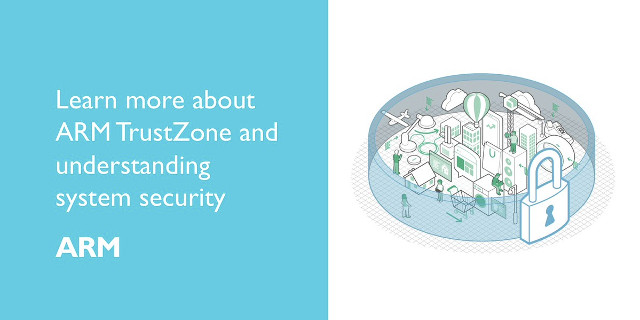Most people understand that securing the IoT is important, but security is a highly a complex subject, and as seen with the many security breaches, even specialists – who in theory should now better – get their devices or online accounts hacked. So even if you are not a security expert, but are involved in the development of embedded systems, it’s important to get acquainted with online and offline security and understand how all this all work, at least from a high level perspective, without necessarily having to dig into the technical details.
ARM is organizing two webinars catering to people who are not security experts, and explaining how they can secure embedded systems using the company’s TrustZone technology.
The first webinar entitled “How to build trust and security into your embedded device” will allow participant to gain an understanding of the security that will need to be applied in their next embedded devices, the technology available, the underlying security principles and different security methods used to protect devices. Examples will be provided, as well as an introduction to ARM security technologies at the end of the presentation.
It will take place on June 14, 2016 with two schedules one for Europe and Asia at 8:00 am (UTC) (i.e. right now…), one for America at 9:00 am (PDT).
The second webinar “Meet the experts: ARM TrustZone – understanding system security” will focus on ARM TrustZone:
ARM’s TrustZone architecture is key in enabling many vital elements of this new ecosystem. The ability to trust code and data and to provide secure access to peripherals, memory systems and communication links is a necessary part of the growing connected world. This webinar will give an overview of the TrustZone architecture as implemented in ARMv8-A systems and then introduce the new TrustZone for ARMv8-M architecture aimed at microcontrollers and deeply embedded systems.
You’ll have more time to get prepared, as it’s scheduled for June 28, 2016 on 8:00 am (UTC) and 9:00 am (PDT).
Both webinars can be accessed here. If you miss the events, recordings will be available.

Jean-Luc started CNX Software in 2010 as a part-time endeavor, before quitting his job as a software engineering manager, and starting to write daily news, and reviews full time later in 2011.
Support CNX Software! Donate via cryptocurrencies, become a Patron on Patreon, or purchase goods on Amazon or Aliexpress





Can you please give a direct link to the recordings?
@ValdikSS
I missed it too, as when I tried to follow the webinar for Asia timezone, I got no audio at all.
I’ve now received an email linking to the recording (allegedly) -> http://pages.arm.com/index.php/email/emailWebview?mkt_tok=eyJpIjoiTmpkbE5EVXpNbVJtWkRJMSIsInQiOiJWRGN2VEJXV2oxVW1Sc0RhQTk2ODUxa3Fncm13RkVFTkNRMlk2VSt4RmpqK1FjYURqYXpzRThMenduaC9mblc5Z2Q5azNic3JwYkp6SUYxN082b1d4ZTAwSkRvQjlicVpsUm9EM1pSQXl3cz0ifQ%3D%3D
But I can’t see how it start it. I wanted to ask, but ARM website registration is not working for me….
So I followed the second webinar.
Basically they have three kind of memories:
1. Non-secure
2. Secure non-callable callable
3. Secure memory
Non-secure can call 2., but no 3., and 2. acts as a gateway between non-secure and secure memory. All code call in 2. must start with SG (Secure Gateway) instructions or access will be denied.
Memory security attributes are defined by SAU (Security Attribute Unit) with optional external IDAU (Implementation Defined Attribute Unit)
They also make clear the secure code is as small and simple as possible to avoid security issue, and it’s mainly used for firmware update, crypto API, keys storage…
They mostly focuses on TrustZone on ARMv8-M, and mentioned support for mbed and CMSIS.
There will be more webinars as well as face to face seminars in UK, US and China @ http://www.arm.com/support/training/arm-training-courses/index.php